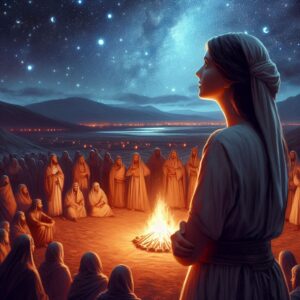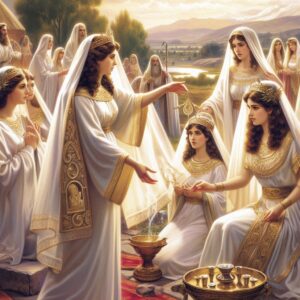The Testimony of Zipporah
Chapter 37 contains Zipporah’s personal account of walking with Moses on the Mount of Ha’Elohim and hearing the words of the Angel of YHVH. She testifies that their “crowns” (likely representing their divine authority or reward) have been prepared. She and Moses have gained YHVH’s patience by giving Him their trust. She is recognized as a helpmate sent by YHVH to Moses, and YHVH receives her prayers, supplications, and honors her songs. This chapter serves to establish Zipporah’s divine calling, authority, and partnership with Moses, validating her role as a recipient of revelation and a teacher. It testifies to her direct spiritual experiences and standing before God.
Tu Kesheh
In Chapter 38, Zipporah and Miriam are explicitly teaching the daughters of Israel. Their teachings focuse on understanding the Sabbaths by observing the stars and moons, which reveal the seasons and the secrets of Ha’Elohim (Hebrew for the gods). YHVH has appointed these celestial bodies for signs, seasons, days, and years. They also taught that if a woman becomes unfaithful, she should be offered teshuvah (Hebrew, return, also understood as repentance) to return to the Covenant path. This chapter aims to instruct the women of Israel in understanding divine timekeeping through celestial signs and emphasizes the path of repentance for returning to the Covenant. It highlights the role of women as teachers of fundamental spiritual knowledge.
The Reading of the Heavens
 Detailing instructions for the High Priestess to teach the Priestesses about “the readings of the firmament, and the expanse of the heavens,” Chapter 39 continues the theme of astrological wonders. The structure of the heavens are described symbolically with twelve rows and seven thrones, occupied by seven malakim (angels) of the seven dispensations. It also describes the symbolism and spiritual significance of various precious stones, linking them to the tribes of Israel, virtues like love, loyalty, wisdom, strength, justice, patience, and spiritual understanding. The Torah is said to be “written upon her” (the night sky) by the finger of YHVH, granting understanding of the Torah. This teaching serves to impart a deeper spiritual understanding of divine order, symbolism, and the connection between celestial patterns, personal virtues, and the Torah to women holding the office of Priestess. It underscores the importance of the Priestesses’ spiritual education and role in accessing divine wisdom.
Detailing instructions for the High Priestess to teach the Priestesses about “the readings of the firmament, and the expanse of the heavens,” Chapter 39 continues the theme of astrological wonders. The structure of the heavens are described symbolically with twelve rows and seven thrones, occupied by seven malakim (angels) of the seven dispensations. It also describes the symbolism and spiritual significance of various precious stones, linking them to the tribes of Israel, virtues like love, loyalty, wisdom, strength, justice, patience, and spiritual understanding. The Torah is said to be “written upon her” (the night sky) by the finger of YHVH, granting understanding of the Torah. This teaching serves to impart a deeper spiritual understanding of divine order, symbolism, and the connection between celestial patterns, personal virtues, and the Torah to women holding the office of Priestess. It underscores the importance of the Priestesses’ spiritual education and role in accessing divine wisdom.
Libations: the Drink Offering
While Chapter 40 is titled “Libations: the Drink Offering” in the Wisdom of Zipporah section, excerpts relating to this practice appear earlier in 3 Sefer Moses. Zipporah and Miriam led the daughters of Israel in pouring out libations of sweet water at Marah to remember YHVH’s blessings (3 Moses 22:6-9). Dinah is also mentioned as pouring libations upon the altar of YHVH (2 Moses 31:2). This practice appears to be a spiritual ritual associated with women and Priestesses. Its purpose is to remember and honor YHVH’s blessings.
The Torah of the Apothecary
The content of Chapter 41 appears to provide excerpts on the uses of a variety of plants, rocks and other things of nature. As the title suggests, its teachings are related to healing, remedies, or spiritual preparation, apothecary. Given its placement in Zipporah’s teachings and her role as a High Priestess, this wisdom pertains to both physical and spiritual healing, preparation, involving natural elements, blessings, or rituals within the domain taught by Priestesses.
Calling upon the Heavens
The teachings found in Chapter 42 are related to prayer, supplication, or communication with the divine. This aligns with Zipporah’s testimony that YHVH receives her prayers and supplications. This chapter contains instructions and principles for approaching God and seeking divine intervention or guidance. However, the methods she teaches would not be as familiar to a modern audience as they would to ancient Israel. This chapter would likely be seen to modern readers as superstition or folk magic.
Overall Themes and Message
The overarching theme of The Wisdom of Zipporah is the centrality of women’s spiritual wisdom, leadership, and active participation in the covenant with YHVH. Zipporah, as a prophetess and High Priestess, serves as a powerful example of a woman receiving direct revelation and co-teaching with Moses. The message emphasizes that divine knowledge, spiritual understanding, and practical application of the Torah are transmitted not only through male leaders like Moses and Aaron but also significantly through female leaders like Zipporah and Miriam. Her teachings highlight a deep connection between the physical world (celestial bodies, nature, physical well-being) and spiritual truths, emphasizing a holistic approach to living in covenant with YHVH.
The Levite women and daughters of Israel
 Zipporah, along with Miriam, directly taught the daughters of Israel about fundamental practices like discerning Sabbaths through celestial signs. Priestesses were to be taught readings of the firmament and symbolism by the High Priestess. Miriam also taught the women in all the ways of YHVH, just as Moses taught the men. Zipporah and Miriam clearly led the Priestesses. This suggests they taught them about the spiritual significance of rituals, like libations, understanding divine patterns, accessing divine power (see Chapter 41 “Apothecary,” and 42 “Calling upon the Heavens”). This was likely to help all the woman, not merely the Levites, to walk in teshuvah towards more righteous living, preparing them for their roles and their personal spiritual journeys.
Zipporah, along with Miriam, directly taught the daughters of Israel about fundamental practices like discerning Sabbaths through celestial signs. Priestesses were to be taught readings of the firmament and symbolism by the High Priestess. Miriam also taught the women in all the ways of YHVH, just as Moses taught the men. Zipporah and Miriam clearly led the Priestesses. This suggests they taught them about the spiritual significance of rituals, like libations, understanding divine patterns, accessing divine power (see Chapter 41 “Apothecary,” and 42 “Calling upon the Heavens”). This was likely to help all the woman, not merely the Levites, to walk in teshuvah towards more righteous living, preparing them for their roles and their personal spiritual journeys.
Readers Today
These chapters teach the reader today about the significant and authoritative role women held in the divine organization presented in these records. They demonstrate that access to divine wisdom, revelation, and leadership was not restricted by gender. They provide specific examples of teachings related to understanding divine timing, celestial order, symbolism, spiritual practices, and connection with God, which can be studied and potentially applied by individuals seeking greater understanding of YHVH’s ways, regardless of gender. They highlight the importance of seeking wisdom from all inspired sources and recognizing the contributions of women in spiritual leadership and teaching.
Who are these Chapter For?
While parts of “The Wisdom of Zipporah” contain instructions specifically for women in certain roles (High Priestess teaching Priestesses, Zipporah and Miriam teaching the daughters of Israel, women pouring libations, ect.), the section as a whole is included within “The Teachings of Moses and Zipporah” which constitutes 4 Sefer Moses, intended for all Israel. The plates of brass, containing this record, are described as “the manna to feed Israel,” not merely some of Israel. While certain applications or roles discussed are gender-specific, the wisdom and spiritual principles contained within this section are likely intended for the benefit and understanding of everyone in Israel. Men are meant to learn from Zipporah’s example, her authority, and the divine structure that includes women in powerful spiritual positions. The spiritual insights on celestial signs, symbolism, and connecting with the divine are universal principles, even if the instruction delivery method within the historical narrative was directed towards specific groups of women.
Conclusion
The Wisdom of Zipporah (4 Sefer Moses, Chapters 37-42) serves as a vital part of the teachings of Moses and Zipporah. It emphasizes the indispensable role of Zipporah, a prophetess and High Priestess, in receiving and imparting divine wisdom. This section provides specific teachings for the women of Israel. It teaches the Priestesses regarding the understanding of divine order through celestial observation, the practice of spiritual rituals like libations, insights into healing, and methods for connecting with the heavens. While rooted in the specific roles and teachings given to women in ancient Israel, the wisdom contained within these chapters is presented as part of the broader “manna” for all Israel, highlighting the importance of women’s spiritual leadership and understanding for the entire community’s growth and preparation.


